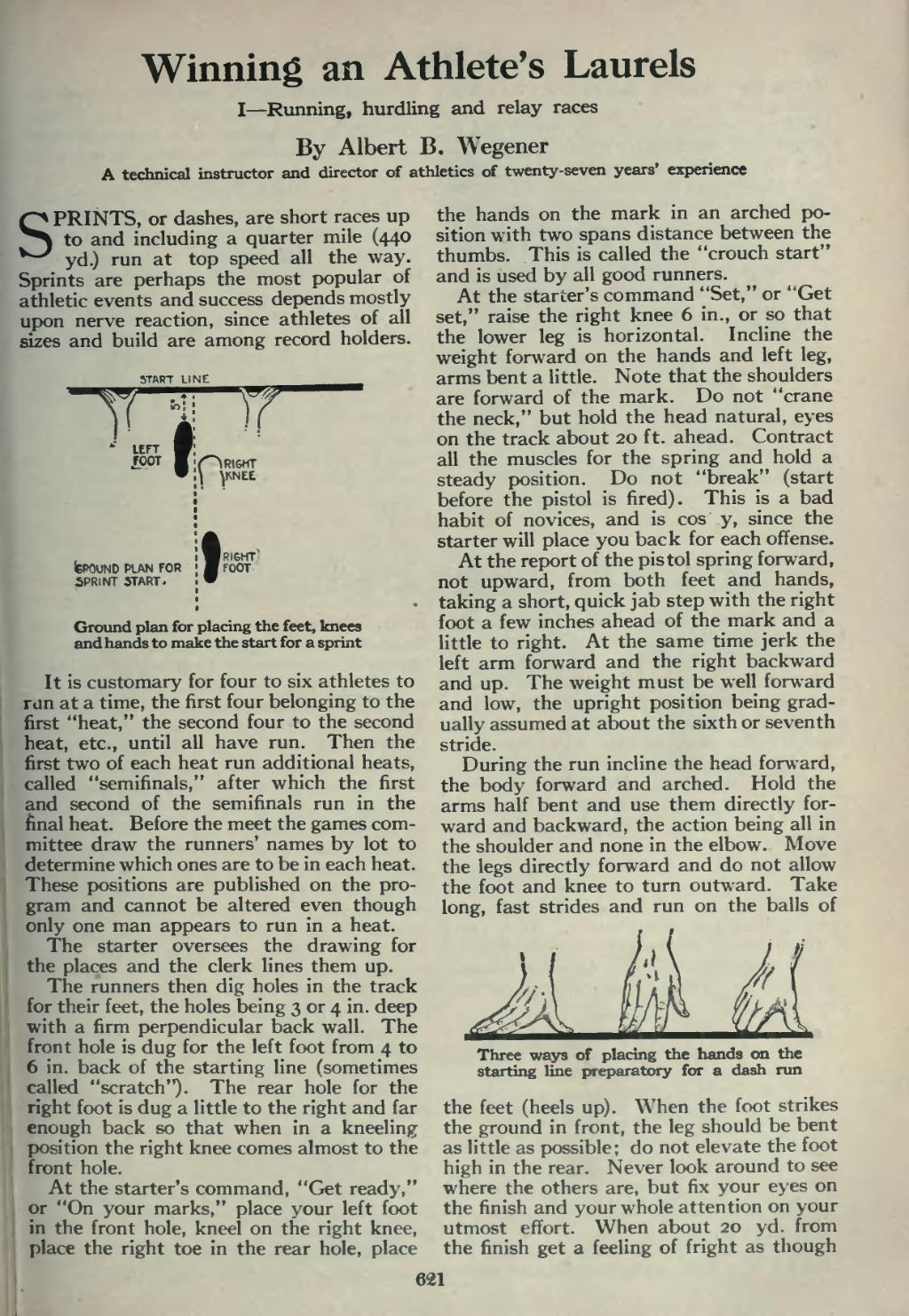Winning an Athlete's Laurels
I — Running, hurdling and relay races By Albert B. Wegener
A technical instructor and director of athletics of twenty-seven years' experience
��SPRINTS, or dashes, are short races up to and including a quarter mile (440 yd.) run at top speed all the way. Sprints are perhaps the most popular of athletic events and success depends mostly upon nerve reaction, since athletes of all sizes and build are among record holders.
��5TftRT LINE
��Y
��LEFT FOOT
��4 ;
��fePOUNO PLAN FOR SPRINT START.
��P1RI6HT
��I
��RIGHT FOOT
��I
��Ground plan for placing the feet, knees and hands to make the start for a sprint
It is customary for four to six athletes to run at a time, the first four belonging to the first "heat," the second four to the second heat, etc., until all have run. Then the first two of each heat run additional heats, called "semifinals," after which the first and second of the semifinals run in the final heat. Before the meet the games com- mittee draw the runners' names by lot to determine which ones are to be in each heat. These positions are published on the pro- gram and cannot be altered even though only one man appears to run in a heat.
The starter oversees the drawing for the places and the clerk lines them up.
The runners then dig holes in the track for their feet, the holes being 3 or 4 in. deep with a firm perpendicular back wall. The front hole is dug for the left foot from 4 to 6 in. back of the starting line (sometimes called "scratch"). The rear hole for the right foot is dug a little to the right and far enough back so that when in a kneeling position the right knee comes almost to the front hole.
At the starter's command, "Get ready," or "On your marks," place your left foot in the front hole, kneel on the right knee, place the right toe in the rear hole, place
��the hands on the mark in an arched po- sition with two spans distance between the thumbs. This is called the "crouch start" and is used by all good runners.
At the starter's command "Set," or "Get set," raise the right knee 6 in., or so that the lower leg is horizontal. Incline the weight forward on the hands and left leg, arms bent a little. Note that the shoulders are forward of the mark. Do not "crane the neck," but hold the head natural, eyes on the track about 20 ft. ahead. Contract all the muscles for the spring and hold a steady position. Do not "break" (start before the pistol is fired). This is a bad habit of novices, and is cos y, since the starter will place you back for each offense.
At the report of the pistol spring forward, not upward, from both feet and hands, taking a short, quick jab step with the right foot a few inches ahead of the mark and a little to right. At the same time jerk the left arm forward and the right backward and up. The weight must be well forward and low, the upright position being grad- ually assumed at about the sixth or seventh stride.
During the run incline the head forward, the body forward and arched. Hold the arms half bent and use them directly for- ward and backward, the action being all in the shoulder and none in the elbow. Move the legs directly forward and do not allow the foot and knee to turn outward. Take long, fast strides and run on the balls of
�����Three ways of placing the hands on the starting line preparatory for a dash run
the feet (heels up). When the foot strikes the ground in front, the leg should be bent as little as possible; do not elevate the foot high in the rear. Never look around to see where the others are, but fix your eyes on the finish and your whole attention on your utmost effort. When about 20 yd. from the finish get a feeling of fright as though
��621
�� �
